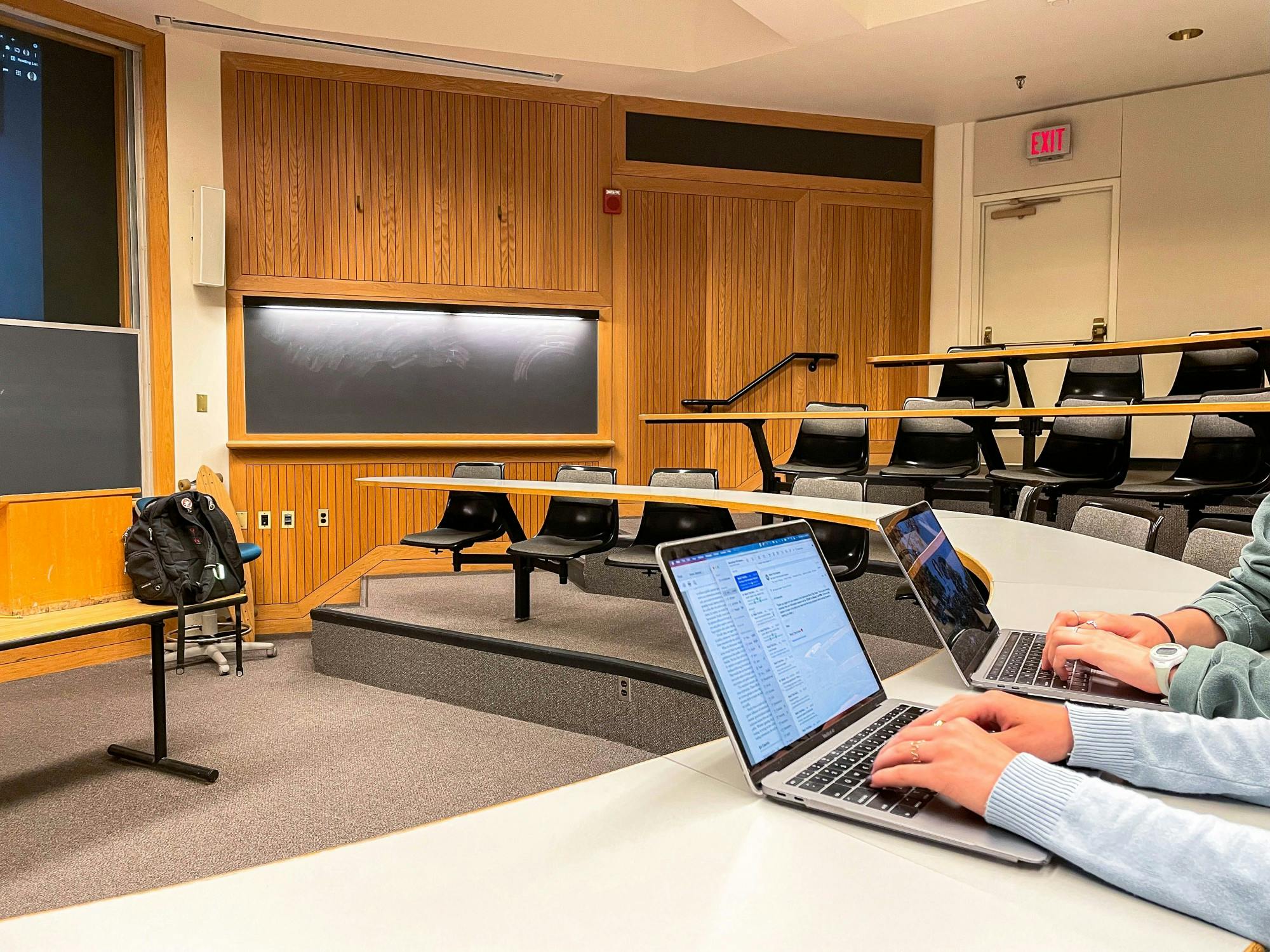After over a year of Zoom learning, thousands of Dartmouth students and professors have returned to the classroom to welcome the new school year.
The 2020-21 school year consisted predominantly of virtual classes, with roughly 10 courses being offered in person during the 2021 winter and spring quarters. Summer term featured 19 fully in-person classes as students and faculty alike received their COVID-19 vaccines and submitted documentation to Dartmouth College Health Services. In a sharp transition from recent terms, 634 classes are in person this fall, according to an email sent to campus from Interim Provost David Kotz and Dean of the Faculty Elizabeth Smith.
The email noted that a few professors with “exceptional” circumstances requested to opt out of in-person instruction. Only 13 courses were granted such accommodations.
Students share first impressions
Aspiring doctor Ramsey Ash ’24 has enrolled in CHEM 51, “Organic Chemistry,” INTS 18, “Global Health and Society” and SPAN 2, “Spanish 2” this fall.
“We had a class discussion in [INTS 18] yesterday, which was so cool because we weren’t in breakout rooms on Zoom,” Ash said. “I really liked being able to meet other people in person and feel like I’m connecting with people who have similar interests as me.”
Adriana Chavira-Ochoa ’24 lived on campus for all three terms of her freshman year and took online classes. Chavira-Ochoa said that it is “a huge shock” to be back in person after the summer and believes in-person classes will allow her to “learn and perform better.”
“I’m loving it so far — it’s so different,” Chavira-Ochoa said. “Meeting the professors in person and my classmates has been such a blessing. I feel more motivated to stay on top of my classes and feel much more interested in my coursework. The last three terms felt so isolated and bland — now the school feels alive.”
Marina Wang ’25 was admitted as a member of the Class of 2024 but decided to take a gap year during which she taught reading, math and science to school-age children via Zoom and road-tripped across the U.S. with other gappers. A large factor contributing to her decision was the shift to online learning, she said.
Wang emphasized that there is “so much more” of a personal connection between classmates and professors in person, noting that there is a better flow in class discussions since students can make eye contact and observe when others are preparing to speak.
“There’s never an awkward lull like in Zoom conversations,” Wang said. “This is especially important in my [HUM 1, “Dialogues with the Classics”] class, where we have a lot of small group discussions and need to hear everyone’s thoughts — and also my [CHIN 4, “Advanced First-Year Chinese”] class because my teacher will often have us recite sentences back to each other to make sure our dictation is correct. It’s great we don’t have to worry about the WiFi cutting out or [having] one person speak at a time.”
Laurel Semprebon ’22 noted that she has found taking LING 1, “Introductory Linguistics,” in person to be particularly impactful.
“The in-person format is most helpful for LING 1 because right now we’re learning a lot about the sounds of the language and how your mouth moves when you make certain sounds,” Seprebon said. “That’s a really hard thing to do over Zoom.”
For similar reasons, Ash waited until he could attend live classes to complete his language requirement to experience in-person drill, also known as the Rassias method of language education.
“I think I’m going to get the iconic [7:45 a.m.] drill slot… I feel like it’s a Dartmouth tradition to do it at least once,” Ash said.
Leina Sato ’24, an international student from Tokyo, first stepped foot on campus as a matriculated Dartmouth student the day before this term began, having attended all of her freshman year classes online from Japan.
Sato said that in-person classes allow for more group work. For example, she tackled her COSC 1, “Introduction to Programming and Computation” problem sets alone last year, but as she transitions to the more challenging COSC 10, “Problem Solving Via Object-Oriented Programming” this fall, she will appreciate the ability to befriend classmates and collaborate on homework assignments.
“Since you can work with a partner on problem sets for COSC 10, I’m especially glad to be back in the classroom because it’s so much easier to find partners than when doing the class virtually,” Sato said.
Professors weigh in
Environmental studies professor James Erbaugh is entering his second year of co-teaching ENVS 3, “Environment and Society” this fall. Erbaugh said that in-person classes bolster his ability to teach and students’ ability to learn.
“In-person classes are great,” Erbaugh said. “For us instructors it means a lot — human interaction, having questions, seeing people, being able to read somebody’s facial expression —or at least half of it. It is a nice change, because I think there’s the very human element to teaching that both exists within remote teaching but at the same time is constrained.”
Anthropology professor Madeleine McLeester is teaching ANTH 11, “Ancient Native Americans” this term. McLeester expressed a similar sentiment, noting that in-person classes allow her to adapt to students’ real-time reactions.
“In class, you can gauge reactions better to the discussion than you can on Zoom, so you can see where people are getting confused or excited and orient your teaching around those two different sides,” McLeester said. “If people are getting confused, you can explain — because you can see it on their faces — and if students are really gravitating towards an idea, you can spend a little more time on that topic.”
McLeester added that, in the classroom, she can overhear snippets of conversation during group discussion that she was not able to hear on Zoom.
“For example, in my last class, I heard students talking about multispecies thinking, so then we can bring that [into the lecture], whereas in Zoom breakout rooms I can only be in one at a time and I can’t hear what’s going on in the other ones,” McLeester said.
Masking policy met with mixed reactions
Although the return to in-person classes resembles pre-pandemic Dartmouth, several aspects of the classroom experience have been modified. For one, the College’s COVID-19 policy requires that students wear masks in class, regardless of vaccination status.
Chavira-Ochoa noted that a major downside to in-person learning is the masking policy.
“I feel like I can’t properly express my opinions since no one can properly hear me,” Chavira-Ochoa said. “Especially in [REL 20.06, “Shamanism: The Agony and the Ecstasy”], participation is a significant chunk of my grade, and I can talk through the mask, but it’s annoying.”
Erbaugh said that while the mask policy is a “minor inconvenience,” it protects the larger community, especially faculty’s children who are too young to receive the vaccine.
“I feel very lucky,” Erbaugh said. “I don’t really have any health concerns and I don’t have any young children who are unvaccinated. I know that’s a big concern for a lot of faculty and something we really need to keep in mind. I want to be able to teach in person for as long as possible, so if [the masking policy] does reduce transmission on the margin, I’m all for it.”
Erbaugh said his main concern about in-person learning is that it may be cut short due to an unforeseen outbreak. Peer institutions have seen such outbreaks — Brown University reported 70 asymptomatic positive COVID-19 cases from Sept. 5 to Sept. 11, prompting additional restrictions to be put in place, and an outbreak at Duke University infected 350 students and 15 employees at the beginning of fall semester, moving some classes online for two weeks.
“I’m ultimately concerned — looking at other universities around the country — that [in-person classes] won’t last, so our course design is resilient,” Erbaugh said. “We can take it remote, but it’s so nice to be back in the classroom [so] I really hope we don’t have to.”
For students who do contract COVID-19 or need time off for physical and mental health, Erbaugh records every lecture and provides the slides online to ensure resources are accessible to all students. He, along with environmental studies professor Richard Howarth and teaching assistant Lan Nguyen GR’23, use microphones to project their voices and ensure the class recording’s volume is audible.
McLeester said that for safety reasons, she has been “very happy” with the mask compliance in her classroom and expressed gratitude that the College opted to enforce it. She added that she has changed her attendance policy and continued to post class notes online to increase accessibility.
“That way, if students aren’t feeling well, they don’t have this pressure to come into class while they wait to go get a [COVID-19] test or be having to make that decision: ‘Oh, I have a little bit of light headache, what should I do? I don’t want to miss class,’” McLeester said. “In my small groups, we are doing online note-taking, so that way if students do end up missing a class either for [COVID-19] or for some other reason, they still have access to the in-class notes.”
Semprebon said that she supports the mask policy as a preventative health measure, even if transmission rates remain low at the College.
“So far, my classes haven’t been overcrowded and people have been good about wearing masks,” Semprebon said. “I’m in support of the mask policy because I think even if we don’t have a lot of [COVID-19] on campus right now, we’ve got plenty of coughs and colds, and I feel like the policy about wearing masks and not coming in when you’re sick is in general a good health measure.”





